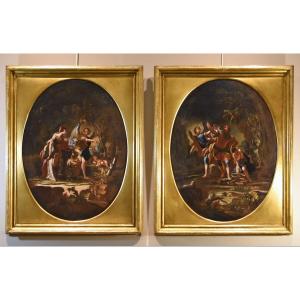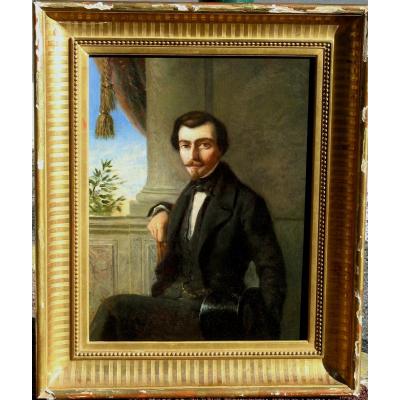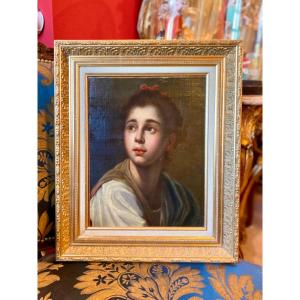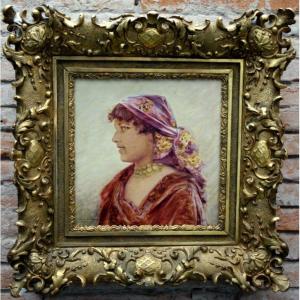workshop / attributable
Quality work depicting David with the head of Goliath (or the Triumph of David)
oil painting on canvas
Dimensions (cm): 109 x 85, framed
Provenance: Bologna private collection
All the details relating to this painting can be viewed at the following - link -
We share a work of great importance, capable of enthusing any connoisseur or collector of works of this caliber, which depicts the victory of David over the giant Goliath, one of the most admired themes in the history of art.
According to the story, narrated in the Old Testament, David first hit his apparently invincible opponent, Goliath, throwing a stone that hit the giant on the forehead, and then used his sword to cut off his head.
We are talking about a seventeenth-century oil painting on canvas, which re-proposes the famous David with the head of Goliath, created by Guido Cagnacci around 1645-50, now housed at the Jean Paul Getty Museum in Los Angeles (link: https://www.getty.edu/art/collection/object/109D0J).
One of the major protagonists of Baroque painting, creator of a passionate and sensual painting but also imbued with great technical skill and a sincere religiosity and contrary to the glories of the Counter-Reformation, Cagnacci traveled a lot during his career; first in Bologna, then in Rome, completing his training at Guercino's studio, and finally in Venice.
In the decade he spent in the lagoon city (1649-1659), where he maintained an active workshop, he tackled the theme of David victorious for the first time, with a painting for the Roman residence of Prince Colonna, and today at the Columbia Museum of Art (South Carolina ). This work became extremely famous: its tone of lightness and refinement, which does not contain any sense of tragedy and struggle, had to make it welcome and appreciated. Link: https://www.kressfoundation.org/kress-collection/artwork/cbe62345394b20f87e3e6dd0598a6510a9f492b93cea2a11cbf605137278f1d2
Starting from the success obtained right away, Cagnacci and his circle later created several variations of this subject, including the one we proposed, where the biblical hero is portrayed with an even more elegant and elaborate style.
Among these we can mention:
- 'David and Goliath' Cremonini-Tamburi Collection of Bologna, with previous attribution to Pasinelli (http://catalogo.fondazionezeri.unibo.it/scheda/opera/58440/Pasinelli%20Lorenzo%2C%20David%20con%20la%20testa%20di%20Golia)
- 'David and Goliath' (1645-1650) from the Paul Getty Museum (https://www.getty.edu/art/collection/object/109D0J)
- 'David and Goliath', Private collection, see General Catalog of Cultural Heritage (https://catalogo.beniculturali.it/detail/HistoricOrArtisticProperty/0300196559)
In the classical and sensual nobility of the David model, it is easy to detect the debt towards the classical Emilian tradition and in particular towards Guido Reni, while the lighting system in the diagonal of shadow that crosses the back wall takes up a typically solution Caravaggesque.
Davide is immortalized here with the formal perfection of a Greek statue on his pedestal, while he turns his androgynous face to the right, portrayed with a meticulousness and formal elegance that give the painting a hypnotic rhythm.
The painter's ability was to estrange the character from the sense of the drama that had just ended, crystallizing the composition into an almost dreamlike stillness, without the slightest trace of fatigue: if it were not for the large decapitated head, and for the sling again. in the left hand, we would struggle to recognize Goliath's executioner, who had just come out of a duel that appeared unequal.
The proposed canvas is the work of an artist from Guido Cagnacci's workshop, most likely executed under the directives of the great master himself, to satisfy the request of the client who was impressed by this splendid subject.
The sumptuous clothing of the young hero deserves a mention, highlighted by the bright blue of the fabrics, and which takes up the tradition of portraying biblical and historical protagonists in luxurious contemporary clothes, which Cagnacci would have admired in the paintings of his Renaissance predecessors including Paolo Veronese, the whose work he studied with great attention, and Caravaggio.
The conservation conditions of the work appear excellent, also by virtue of the quality of the pigment used, the pictorial layer does not present any kind of problem. The painting is sold complete with a nice antique wooden frame.
Like all our objects, the work is accompanied by a certificate of authenticity and a descriptive card.
We take care and organize the transport of the purchased works, both for Italy and abroad, through professional and insured carriers.
Contact us for any information, we will be happy to answer you.
Follow us also on:
https://www.instagram.com/galleriacastelbarco/?hl=it
https://www.facebook.com/galleriacastelbarco/






























 Le Magazine de PROANTIC
Le Magazine de PROANTIC TRÉSORS Magazine
TRÉSORS Magazine Rivista Artiquariato
Rivista Artiquariato
